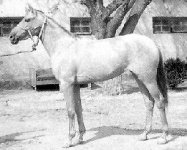♘امیرحسین♞
♘ مدیریت انجمن اسب ایران ♞
Also Known By: Karabakhskaya (Russian)
The Karabakh is an ancient mountain saddle breed. It was developed in Nagorny Karabakh in Azerbaijan between the Araks and Kura rivers.
Prior to the 19th century the Karabakh had a substantial influence in improving horse breeds in the neighboring countries. It was developed by crossing the native Azerbaijan horses with Persians, Arabs and Turkmenians. The Arabian influence was most pronounced; there are important similarities in appearance between the Karabakh and the Arabian.
Long-term breeding based on taboon management in the mountains has led to the evolution of specific features in the breed. The horse is not large; its build is clean and thick-set; the muscles are well developed and the tendons are well defined. The head is small and clean-cut; the profile is straight and the eyes alert. The neck is set high and average in length; the withers are average in height; the back is average in length; the loin is flat, short and wide; the croup is average in length , wide and well muscled; the chest is deep. The limbs are properly set, sometimes bowed; the hoofs are not large yet solid. The skin is thin; the hair is soft and gleaming; the hair of the forelock, mane and tail is thin. The color is chestnut, or bay with a characteristic golden tint. The average measurements (in cm) of stallions are: height at withers 150, oblique body length 147, chest girth 169, cannon bone girth 18.6; mares: 146, 145, 164 and 18.5 respectively.
Breed numbers are very small. At present, the Karabakh is bred at Agdam stud, yet the total herd is composed of Arab Karabakh crossbred of various grades. Effort are currently under way to regenerate the Karabakh breed. In 1981, Volume 1 of the studbook was published.
The Karabakh is an ancient mountain saddle breed. It was developed in Nagorny Karabakh in Azerbaijan between the Araks and Kura rivers.
Prior to the 19th century the Karabakh had a substantial influence in improving horse breeds in the neighboring countries. It was developed by crossing the native Azerbaijan horses with Persians, Arabs and Turkmenians. The Arabian influence was most pronounced; there are important similarities in appearance between the Karabakh and the Arabian.
Long-term breeding based on taboon management in the mountains has led to the evolution of specific features in the breed. The horse is not large; its build is clean and thick-set; the muscles are well developed and the tendons are well defined. The head is small and clean-cut; the profile is straight and the eyes alert. The neck is set high and average in length; the withers are average in height; the back is average in length; the loin is flat, short and wide; the croup is average in length , wide and well muscled; the chest is deep. The limbs are properly set, sometimes bowed; the hoofs are not large yet solid. The skin is thin; the hair is soft and gleaming; the hair of the forelock, mane and tail is thin. The color is chestnut, or bay with a characteristic golden tint. The average measurements (in cm) of stallions are: height at withers 150, oblique body length 147, chest girth 169, cannon bone girth 18.6; mares: 146, 145, 164 and 18.5 respectively.
Breed numbers are very small. At present, the Karabakh is bred at Agdam stud, yet the total herd is composed of Arab Karabakh crossbred of various grades. Effort are currently under way to regenerate the Karabakh breed. In 1981, Volume 1 of the studbook was published.



